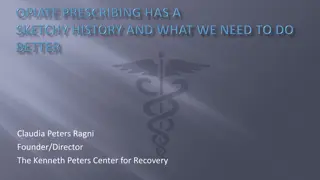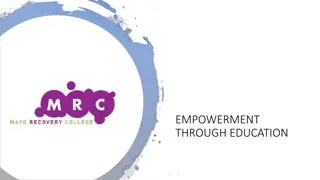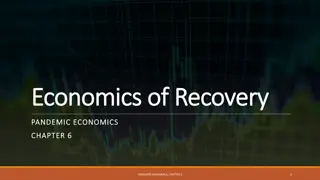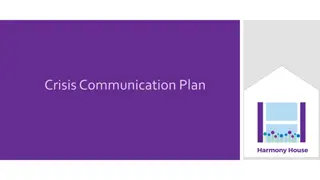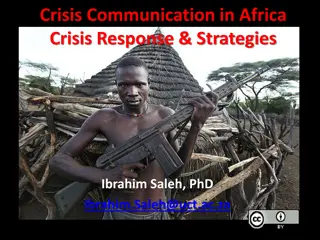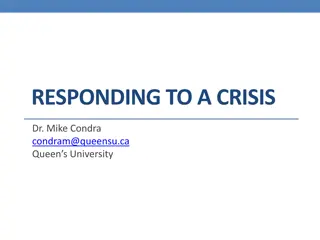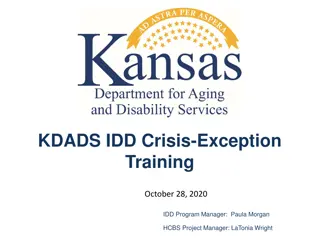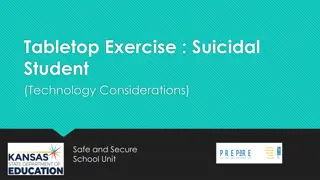Steps to Recovery and Mitigating the Impact After a Crisis
Schools face various crises that can significantly impact the mental and physical well-being of students and educators. It is crucial to understand the nature of a crisis, have a comprehensive crisis management plan, and respond effectively to minimize harm. Long-term mental health needs must also be addressed to support recovery and prevent further distress. Coordination, preparation, and a calm response are essential in managing crises in educational settings.
Download Presentation

Please find below an Image/Link to download the presentation.
The content on the website is provided AS IS for your information and personal use only. It may not be sold, licensed, or shared on other websites without obtaining consent from the author. Download presentation by click this link. If you encounter any issues during the download, it is possible that the publisher has removed the file from their server.
E N D
Presentation Transcript
Tragedy Strikes, Now What? RECOVERY AFTER A CRISIS AND STEPS TO MITIGATE IMPACT SALLY MCDANIEL, LMFT & BILL EUBANKS, LMHC GREATER LAKES MENTAL HEALTHCARE/MULTICARE BEHAVIORAL HEALTH
What is a crisis Schools experience a wide variety of crises that have the potential to harm the mental and physical health, learning environment, and safety of students and educators. A school crisis is any traumatic event that seriously disrupts coping and problem-solving abilities of students and school staff. It is typically sudden and unexpected. A crisis can cause a drastic and tragic change to the environment. This change is generally overwhelming and uncontrollable as well as unwanted and frightening. It may create a sense of helplessness, hopelessness, and vulnerability combined with a loss of safety.
School Crisis Guide Components Prevent- Create Positive School Climate Prepare- Creating a Plan, Training, Communication Respond- The 1sthour-1stweek Recover- Long term mental health needs, & reassessing current/future needs
Multiple types Personal Violence School related Car accident Community Violence-Shooting Predatory Situation Suicide Gang Activity Bus accident Health related illness/death School fights/threats Teacher/staff death Other Accidental death Global Crisis/News School Fights/Police presence Fire Lock downs Playground, sport, or campus injury Assault toward teacher/staff
A crisis has occurred Once a crisis occurs, schools must be prepared to address mental health implications to reduce further distress or secondary crises. Repeated and continued exposure to such stressors has been shown to cause changes in the developing brain structure, further exacerbating a young person s challenges to success in school and life (Anda et al., 2006; Lupien,McEwen, Gunnar, & Heim, 2009).
RESPOND The response phase includes the steps taken to minimize harm to people and property during a particular incident. Its focus is on the short-term, direct effects of an incident and requires tight coordination and rapid action among all participants. This includes executing the emergency plans developed and practiced in the preparedness phase It is extremely important to remain calm and execute in an organized manner. It is very distressing to the school culture if it appears disorganized.
First response How do you receive the news, how do you verify the information? Who is on the crisis response team, how are they notified? Process and Protocol Inform teachers Inform students Inform parents Is there a central place for staff and students to go to help them process and ask questions? How do you assess the potential impact the crisis may have
The Role of the School Crisis Team This group needs to be highly visible in the school and will likely need to meet 2-3x/day (morning, lunchtime, afterschool) to coordinate all response activities and ensure strong communication. Depending on the type of incident or tragedy, others may join this group including the superintendent, the lead mental health support, etc.
Maintaining Communication Identify one point person for internal and external communication. Avoid use of public address systems or large assemblies to make announcements. Frequent communication with parents/guardians and the community is key as it provides reassurance that the school has a good plan and can be a reminder of supports available to students and the greater community. Protect Students from Being Re-Traumatized: The focus of all communications, including media coverage, should be on the protection of students and the school environment from unwanted intrusive attention. Television coverage of the event should not be watched in the classroom during school hours. Information about how to handle media requests can be distributed to parents.
Support for staff Notify Teachers and Other Staff First. Meet before school with school teachers and other staff to discuss what is known about the death/incident. This gives teachers an opportunity to ask any questions they wish and to prepare themselves before they see their students in class. If a teacher does not feel able to talk to his/her students about the death/incident, a member of the crisis team should be available to step in or assist with the notification. Educators often struggle to lead sense-making in the aftermath of traumatic events. To support students and model positive coping, educators must make sense of and then cope with the event for themselves first. On the one hand, school personnel are in the unique position to model expressions of grief, encouraging and assuring students that adults and students alike are struggling to understand the unexpected death (Balk et al., 2011, p.154). Yet they often are not trained, resourced, or supported to model grief, and may not know how to process the event, experiences, and effects. A recent study found that only 7% of classroom teachers received bereavement training (American Federation of Teachers/New York Life Foundation, 2012).
Identifying Students/Staff of Concern In the hours or days after an incident, the School Crisis Team can make a list of students and staff who are most impacted. This may include siblings, best friends, teammates, current or former classroom teachers, coaches, etc. Additionally, students or staff can be identified who may not be directly involved but may be vulnerable (those who have experienced recent loss, etc.). The School Crisis Team can make a plan for who specifically will check in with the people on this list, what supports can be offered and at what intervals the check ins should occur. Pay attention to students who are having particular difficulty, including those who are either withdrawing from others or congregating in hallways and bathrooms. Encourage them to talk with counselors or other appropriate school staff.
School Scheduling Prepare a Statement for Students. Adults often struggle with what to say. With a prepared statement, teachers can give the same information to all students simultaneously. This should be done in small, naturally occurring groups such as homeroom/advisory or first period classes; every effort should be made to ensure that all students are present at the time this information is shared. Include information about the availability of mental health and support services and how students may access those services. Routine and flexibility are key parts of the recovery process. As best as possible, maintain a regular class schedule with readily available options outside of class for students who are not able to engage in the classroom (such as a staffed quiet space). This may include having regularly scheduled exams or events but readily giving students a makeup or alternative option. Assign a staff member to follow the deceased student s schedule to monitor peer reactions and answer questions. It is also important to monitor staff reactions to the death.
Consider Outside Support Even small-scale incidents can have significant reverberations for a school community. It can be hard to ask for or accept outside assistance, but this is often necessary to bolster your in-house supports. Mental health supports may include school counselors from another school district, providers from your local designated agency (Crisis Team, Outpatient programs, School Services) Established screening protocols for assessment and referral to additional services. For staff/faculty, the Employee Assistance Program. If possible, arrange for several substitute teachers or floaters from other schools within the district (or outside consultants) to be on hand in the building in case teachers need to take time out of their classrooms.
Death by Suicide Stigma and the risk of suicide contagion or copycat suicides indicate that the response to a suicide death should be handled in a certain way. Utilizing best practices can mitigate risk while promoting healing and resilience. These include tip sheets on how to talk about suicide and specific language to use/not use. It is important that the school response to a suicide death is similar to the response for any other death. Having a written protocol is recommended so that decisions are made in an equitable way, especially related to fundraising for the impacted family, memorials including yearbook commemorations, and the school s involvement with funeral or memorial service arrangements.
Cultural Differences Be aware that the extent to which people are able to talk about suicide varies greatly, and in some cultures, suicide is still seen as a moral failing. Be sensitive to the beliefs and customs regarding the family and community, including rituals, funerals, the appropriate person to contact, etc. Be sensitive to how the family or community may need to respond to the death before individuals outside of the family or community intervene to provide support. Ensure the person who is communicating with family is culturally aware to act as a liaison between the family, community, and school if key members of school staff are not from the same racial, ethnic, or religious group as the person who died by suicide. Bring in interpreters and translators if there are language differences. If possible, have resource materials in different languages available for parents.
Student Support 1) Contact and Engagement. Ensure initial contact with students is compassionate, respectful, and calm. Ask students what they need and listen to their responses and requests. 2) Safety and Comfort. Enhance immediate and ongoing safety and provide physical and emotional comfort. Provide accurate and up-to-date information about the event and the current response procedures. Reassure students that emergency and school personnel are doing everything they can to keep people safe. Ask students if they have questions about what they can expect and respond with practical information and resources. 3) Stabilization. Calm and orient emotionally overwhelmed or disoriented students. Use grounding techniques to bring students back to the physical present. For example, ask students to take slow, deep breaths or name five non-distressing objects they see around them. 4) Information Gathering. Identify immediate needs and concerns and gather information. Ask students open-ended questions to understand what they need and how you can help. For example: What are you feeling? Who would be helpful to be around or talk to right now? Do you need any information about what is going on or what to expect? Ask them to identify the student s friends who may need assistance.
5) Practical Assistance. Offer practical help to students in addressing immediate needs and concerns. Provide support and resources that increase a sense of empowerment, hope, and restored dignity. Assist students to identify needs and problem-solve possible solutions. Help students create a manageable and achievable short-term plan. Drop in groups, focus groups, and one on one supports are necessary to support student needs 6) Connection with Social Supports. Establish contact with primary support persons and other sources of support, including family, friends, and trusted school personnel. Ask students who they want to contact and if they need help reaching them. Model support by providing reflective, clarifying, and empowering comments. 7) Information on Coping. Provide information about stress reactions and coping to reduce distress and promote adaptive functioning. Remind students that there is no right way to react to or grieve a tragedy. Provide information on adaptive coping action such as connecting with support systems, taking care of everyday physical needs, engaging in positive distracting activities, and using calming self-talk. 8) Collaborative Services. Provide direct and effective linkages for students to available supports and services, immediate and ongoing. This can include in-school mental health services, local counseling centers, and grief or trauma-specific support groups. More extensive services will be needed in the immediate aftermath of a school-wide crisis. Consider having support and counseling services available to students and school personnel before, during and after school hours in the immediate aftermath.
Reactions in Children Children will show a wide variety of reactions. There is no normal reaction to stressful events. Some reactions include: Tearfulness, sleep issues, separation or bedtime anxiety, and regression in behaviors. Emotional numbness, increased startle responses, withdrawal, and physical symptoms like racing heartbeat, nausea, and changes in appetite. Poor focus in class, attendance issues Other fears, mental health issues, sudden lack of caring about anything (apathy) Retaliation, anger Copycat
Students may also have feelings of regret, particularly if they believe they had mistreated the individual in the past. Adolescents may be particularly vulnerable as a group with an increased risk of feeling depressed or anxious and engaging in self-blame or guilt related to the loss. Students may show a decline in school performance & the ability to master new material Children may show that they are upset when discussing what happened. They may cry, get anxious or angry, or show you in some other way that they are upset. Remember, it is the events that are upsetting them, not the discussion. Talking about the event will provide them the opportunity to show you how upset they really are.
Its Not All Negative These types of events, while tragic, can sometimes lead to positive opportunities. They become opportunities to open, or reopen, channels of communication among family members/school family. They may provide opportunities to value each other more and to express appreciation for one another. They may provide opportunities for families/schools to better plan how they will cope with future difficult times or topics. Build a sense of connectedness and sense of community It is important to focus on what might positively emerge from this tragic event while we also acknowledge tragic loss.
What Teachers & Staff Can do 1. Listen to what students want to share with you. It may be difficult but just listening can be a powerful healing force. 2. Protect students from becoming re-traumatized. Sometimes other students may ridicule or bully students who are highly emotional or cry. 3. Connect with students who have suffered a loss by asking how they are doing; checking in with them on a regular basis; letting them know that you are available to listen; or giving them positive feedback about their attendance or classroom work. 4. Model adult behavior that shows them how responsible adults react to loss and respond to a crisis. Adults may grieve, but they continue to act with consideration and maintain calm routines at school. 5. Teach Crisis counselors can teach students about the common signs and symptoms of grief and/or trauma so that students can assess and understand their own behavior and learn new ways of coping.
Support for parents How do you inform (phone call, email) How to talk to kids- Provide handouts Inform them about signs to look for Who to call with concerns or questions Common concerns and response from parents/families
RECOVER The recovery phase is concerned with restoring the learning and teaching environment after an incident. It is the process of mending the physical and psychological health of school community members, as well as restoring physical facilities to re- establish a positive learning environment. Its aim is to develop and implement plans to ensure school services and facilities are restored. In addition, recovery includes evaluating the incident and the response to it in order to revise and improve school safety and emergency response.
Mitigation Steps Determine who is on the School Crisis Intervention Team and who is in charge of prevention programs at school. Connect school with police, fire and other agencies to assess potential risks. Review risk and resiliency data. Review policies and procedures and consistently apply them. Train school staff in identification of at-risk youth. Train school staff in emergency response and crisis intervention. Identify and implement effective prevention programs and strategies. Vigorously enforce violence and bullying prevention programs. Strengthen efforts to provide a safe, caring and responsive school environment. Work with school and community resources to provide intervention and treatment services for substance abuse, depression, physical and sexual abuse, anger management and other psychological needs. Encourage students, staff, families and community members to provide input and feedback. Evaluate and update your prevention efforts annually.
Best practice Do not overreact General/universal screeners for mental health and at-risk youth BYI-2; SBIRT; Strengths & Difficulties; check yourself; Global Appraisal of Individual Needs Wellness plans for all students/staff Central location for wellness plans (updated mid-year) Wellness team meetings Central location for Safety Plans/Risk Assessments Year to year/School to school Safety team meetings Get to know the safety officer/how to contact Staff Training Prevention Programs Resources material readily available (SAMHSA, Pierce County, and others)
Resources NEA S School Crisis Guide https://www.nea.org/sites/default/files/2020- 07/NEA%20School%20Crisis%20Guide%202018.pdf After A Suicide Toolkit- https://sprc.org/wp- content/uploads/2022/12/AfteraSuicideToolkitforSchools.pdf SAMSHA- https://www.samhsa.gov/find-help/national-helpline https://www.piercecountywa.gov/6958/For- Families#:~:text=If%20you%20or%20a%20loved,the%20crisis%20line%2 024%2F7.










